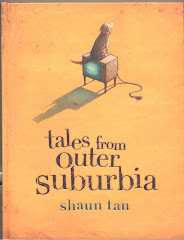We all have them: "the marathon reads." Books that are massive, or relentlessly earnest, or simply unappealing in style and tone. These were the books at the bottom of the pile by my bedside, and although each title has something to recommend it, each represents a marathon read indeed.
The Mysterious Benedict Society, by Trenton Lee Stuart
Little, Brown, 2007. ISBN: 978-0-316-00395-7 (485 pages)
Stuart's book was a New York Times' bestseller, and continues to enjoy a following of dedicated readers, working through at least one sequel. The lengthy, but uncomplicated, plot involves a band of gifted misfit children, handpicked by an eccentric billionaire to save the world from the dastardly plot of a criminal mastermind. There are some humorous moments, and the characters are individualized, and interesting at times, but the story is slow-moving, especially in the first third of the work. Curious coincidences abound, and the ending seems contrived and rather clumsy. Tthe overall effect is of screenplay. However, the book's champions find the problem-solving elements compelling, and the good vs. evil struggle continues to attract and retain a number of different readers. Student readers in our school district have awarded the book a 5/5-star review.
The Corps of the Bare-Boned Plane, by Polly Horvath (CAN)
Groundwood, 2007. ISBN: 978-0-88899-851-4 (269 pages)
Horvath has published a number of novels for "tween" readers in recent years, and has been very well-received by the BC literary community, winning the Sheila A. Egoff Children's Literature Prize for this novel, and for two of her previous works. The plot involves a kind of extended, forced, family reunion on an imaginary island off BC's West Coast. Two girl cousins in their early teens find themselves orphaned suddenly, and are adopted by a rich but eccentric uncle. Staying with him at his isolated island retreat, they learn that the island is littered with the wreckage of planes from a failed Air Force experiment, and they conceive a plan to build their own escape plane. Supporting characters, such as a mysteriously talented butler and a melancholy Yiddish housekeeper, emerge, and as the story unwinds -- extremely slowly -- some miraculous coincidences come to light and tie the characters' stories together.
This is a novel that I found very hard to stay with, and even harder to consider a young audience for. Horvath's characters are not very well-developed, and, indeed, the housekeeper is painted in disturbingly stereotypical colours. An overarching theme is absent, and much of the action is simply not credible -- Social Services sends two teenaged girls to live with a bachelor uncle on an isolated island? As a BC resident, Horvath has provided some authentic detail in her setting, but overall, this book lacks appeal.
Solar Storms: A Novel, by Linda Hogan (US)
Scribner, 1995. ISBN: 978-0-684-82539-7 (351 pages)
Our school district has this novel on our recommended learning resources list, and I reviewed it as a part of a wider look at Aboriginal texts. Stylistically, Solar Storms does not read like the majority of Native-coming-of-age stories, and has much to recommend it as a literary work. Unfortunately, both the gravity (and perhaps, to contemporary Canadian readers, the accessibility) of the content, and the density of the descriptive prose, make this a very challenging, slow, read.
The story involves the journey of a four Native American women to the Northern [Canadian?] ancestral home of the great-grandmother. Each woman grapples with her own sense of identity and self-worth, but the story centres around the character development of the great-granddaughter, who has been horribly abused by the natural mother she re-encounters late in the novel. The women's personal journeys play out against the backdrop of profoundly invasive, large-scale industrial development in the North, and the struggle to validate Aboriginal rights to land is heartbreakingly illustrated.
Hogan is Chickasaw, from Oklahoma, and her sense of detail, especially in describing setting, is precise, evocative, and deeply poetic. You simply can't rush through this story -- the journey itself seems to unfold in "real time" -- and yet the action seems removed and distant from readers. Hogan is showing us so much that is vital, yet I'm not sure I have met the teen reader able to follow this dense, dense novel to its conclusion.
Friday, May 28, 2010
Subscribe to:
Comments (Atom)
